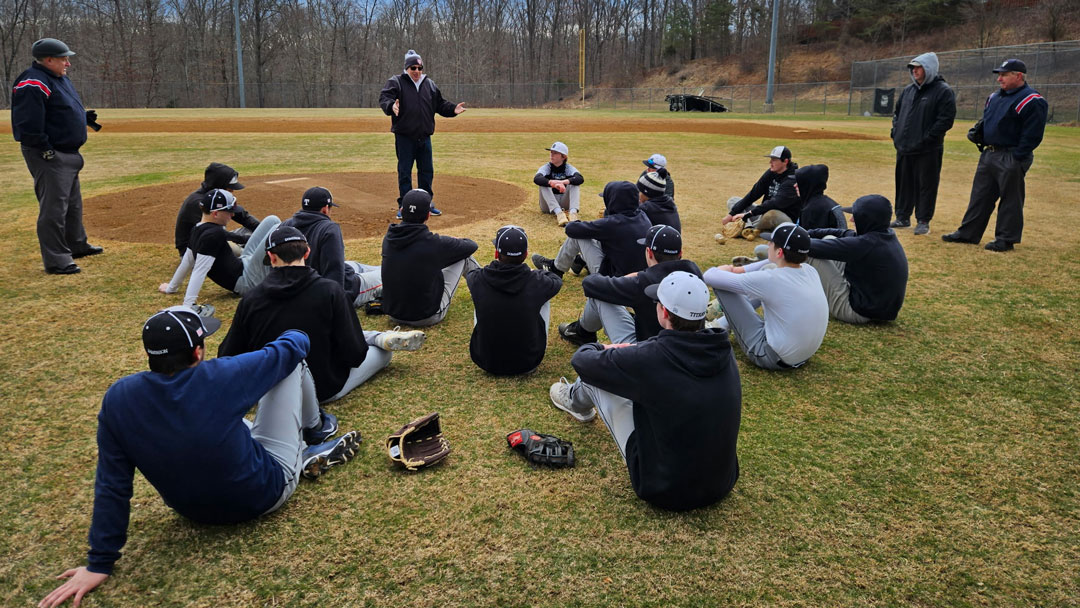An Afternoon with Titans
On March 8th, MAC/NVBUA Director of Training, Paul Porto and a crew of association umpires were assigned a scrimmage at Titans Field home of the Dominion High School of Loudoun County Public Schools. Scrimmages are a vital part of any baseball pre-season and by extension, the baseball season itself. Coaches use scrimmages to help them determine which players will fit into which defensive positions as well as the batting order. Players “get their reps” at scrimmages to hone their skills for the season ahead. And umpires, too, use scrimmages to help serve the famous quote from Hall of Fame umpire Nestor Chylak, “The way I see it, an umpire must be perfect on the first day of the season and then get better every day.” An umpire cannot be expected to have been away from the game for several months and simply step on the field and be at their very best. Scrimmages are the bridge from “having been away from baseball” to “ready for baseball”. Let’s look in on Paul and the gang at Dominion….
Group Photo – During a break in the action, Paul and his crew take a group photo with all of the Dominion players present that day. The crew then closed the day with an open questions and answers period followed by working with the team’s catchers in the cage to review the strike zone and how as catchers they can best receive (or dress) pitches to present as strikes.
Table of Contents
Issue #5 – March 17, 2025
Photo Captions
Speaking with Head Coach – Paul and his partner, Little League World Series umpire and member of the MAC/NVBUA training staff, Darren Schuberg speak with Dominion High School junior varsity coach Austin Behring about a new development for high school baseball in Virginia this year. For 2025, as was discussed on the pre-season online clinic, VHSL has brought down from college baseball the 45-foot-line-coaches conference. It’ll take some time for this new procedure to sink in and become part of the high school game. And it’s in low-key interactions like scrimmages where umpires like Paul and Darren can talk with coaches about how this is all supposed to work. The umpires always work together throughout an entire game to get every call correct. Coaches who have questions about a call can simply ask for time, wait for time to be granted, go to the 45 foot line in front of their dugout and speak with the umpire that made the call there. There’s no negative visuals of coaches storming and charging across the field at umpires when this conference protocol is used as VHSL has directed.
Speaking to players – Paul is addressing the players. NFHS and VHSL tell the community of high school sports that the “fields of play are extensions of the classroom”. What would a teacher or school administrator allow or disallow from a student within a classroom? What should coaches and yes, umpires (we have a role here, too) allow or disallow from a student-athlete on the field of play? Paul talks about the player’s responsibility to their education, their team and most importantly their personal conduct on the baseball field. For a young amateur player, engaging with an umpire can be a very uncertain and anxious thing to do. Most of us played baseball as kids. Think about a time when you were a kid playing baseball and you got the feeling. I need to ask the umpire something…I am confused about something that just happened…I want to be respectful without questioning his judgement or authority…how do I best do that? Paul covered all of that, too.
A new season of baseball always brings new rules, rules changes and or modifications. The players and coaches and umpires need to know all the rules…old and new. Umpires are tested on the rules. Rule books are available to coaches and players, too…and it’s also helpful to have an umpire like Paul come to discuss the rules and take questions about the rules. In addition to the rules, Paul also reviewed this year’s points of emphasis. For 2025, the windup and set pitching position are more defined in the NFHS high school rule book. In the judgement of the umpire(s), if the pivot foot is parallel to the rubber, the pitcher is by rule in the set position. What can a pitcher legally do and not do from the set? And again by rule, if the pivot foot is anything but parallel the pitcher is in the windup. Again, what can a pitcher legally do and not do from the windup?
Next up on Paul’s agenda was discussing the nuances of the force play slide rule and obstruction at the plate. Like all rules, the rules governing these two situations are clearly defined in the NFHS high school rulebook. Both FPSR and obstruction have elements of safety. All of the adults around youth sports want these amateur youth athletes competing to the best of their abilities and doing so in the safest way possible to minimize everyone’s risk. That’s what these rules allow all of us to do.


